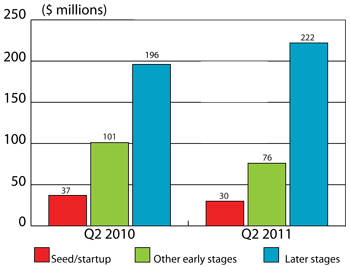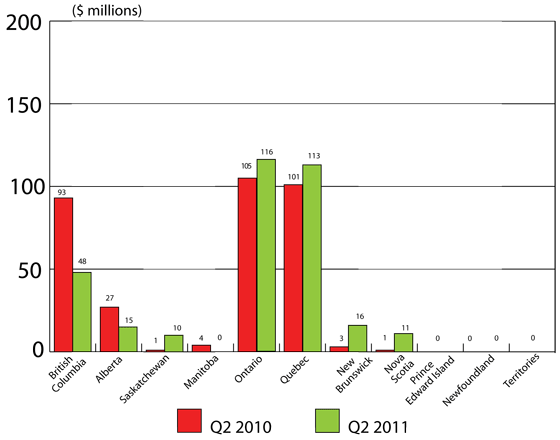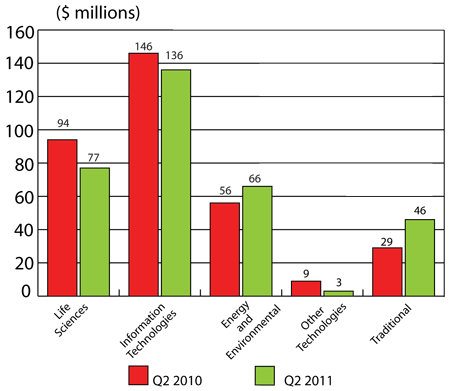PDF Version
Venture Capital Monitor - Q2 2011
644 KB, 7 pages
Canadian high growth innovative small and medium-sized enterprises (SMEs) that commercialize research depend to a large extent on the venture capital (VC) industry for funding. Therefore, a strong VC industry is important for the growth of this segment of SMEs. The goal of this series is to provide current information about the VC industry in Canada. To this end, the series will track trends in investment activity, report on topical VC-related research and look at key technology clusters where VC investment is taking place.
Introduction
This issue discusses venture capital (VC) investment and fundraising activity in Canada during the second quarter of 2011. It also describes recent government activity by the Business Development Bank of Canada (BDC) and provincial governments in support of VC. Finally, it includes an article on a recent survey completed by the National Angel Capital Organization on investment habits by angel investor groups across Canada.
VC activity overview
Investment and fundraising
Slight drop in year-over-year activity
While there were more deals completed in Q2 2011 (135) than Q1 2011 (122), average deal sizes fell significantly resulting in a slight drop in overall VC investment levels during Q2 2011 ($328 million) compared to Q2 2010 ($335 million) (Table 1). Total investments were down slightly from $358 during this quarter compared to Q1 2011. Despite this, through two quarters, Canadian VC investment remains on track to outpace the previous three years of investment.
| Q2 2010 | Q2 2011 | % Change | |
|---|---|---|---|
| ($ millions) | |||
| Source: Thomson Reuters Canada 2011. | |||
| Investment | 335 | 328 | −2 |
| Fundraising | 308 | 132 | −57 |
Figure 1: VC Investment by quarter, 2009 to 2011

Source: Thomson Reuters Canada 2011.
In contrast to improving investment levels, Canadian VC fundraising activity continues to remain tepid with only $132 million committed to VC funds during the quarter. This represents a 57 percent decrease from the $308 million committed over the same period last year. While all investor types experienced poor fundraising, private independent fundraising remained particularly affected, attracting only $34 million during Q2 2011. Increasing overall investments combined with decreased fundraising indicate that less capital will be available for investment in future periods.
Deal size
Q2 2011 average deal sizes 14 percent smaller than Q2 2010 deal sizes
During Q2 2011, 135 firms received VC financing, which is an 11 percent increase from the 122 deals completed in Q2 2010 (Figure 2). Despite an increase in completed deals during Q2 2011, average deal size fell 14 percent relative to Q2 2010. The number of deals worth less than $1 million increased substantially during the quarter while deals worth $5 million or more declined (Figure 2).
Figure 2: Distribution of VC investment by deal size

Source: Thomson Reuters Canada 2011.
Stage of development
Decrease in seed/start-up investment, but increase in later-stage investments
Approximately 68 percent of VC invested into Canadian companies in Q2 2011 was in the form of later-stage financing. There was $222 million invested into later-stage companies during Q2 2011 representing a 13 percent increase from Q2 2010 figures. Average deal sizes for later-stage deals fell from about $2.9 million in Q2 2010 to approximately $2.4 million during Q2 2011, indicating that VCs are investing smaller amounts to more companies at later-stages. Seed and start-up investments fell slightly, while the value of all other early stage investments fell more substantially during Q2 2011.
Figure 3: VC investment value by stage of development, Q2 2010 and Q2 2011

Source: Thomson Reuters Canada 2011.
New versus follow-on investments
High level of follow-on investments observed during the quarter
First-time VC deals increased in Q2 2011 (54) compared to the same period the previous year (47). The combined value of new Q2 2011 deals was just over $97 million, a 10 percent decline from Q2 2010. As expected, the majority of new financings during the quarter occurred as later-stage investments with seed and start-up deals remaining the same year-over-year.
There were 81 total follow-on deals during Q2 2011, making it the most active quarter in terms of follow-on deals since 2009. Total deal value of follow-on deals during the quarter measured just over $230 million (Table 2).
| Investments | Q2 2010 | Q3 2010 | Q4 2010 | Q1 2011 | Q2 2011 | |
|---|---|---|---|---|---|---|
| Source: Thomson Reuters Canada 2011. | ||||||
| New | Seed/ start-up | 12 | 5 | 5 | 20 | 12 |
| Other early stages | 7 | 4 | 9 | 20 | 12 | |
| Later stage | 28 | 32 | 34 | 35 | 39 | |
| All | 47 | 41 | 48 | 58 | 54 | |
| Follow-on | Seed/ start-up | 11 | 9 | 14 | 9 | 15 |
| Other early stages | 24 | 28 | 12 | 22 | 19 | |
| Later stage | 40 | 30 | 41 | 37 | 47 | |
| All | 75 | 67 | 67 | 68 | 81 | |
Type of investor
Increase among government, retail and foreign investors
Foreign funds, retail funds, Labour Sponsored Venture Capital Corporations (LSVCCs) and government funds all experienced increased investment levels during the most recent quarter. In particular, LSVCC's were the most active investors during the quarter with $88 million invested, the single highest investment levels by LSVCCs since 2009. In contrast, private independent investment fell during the quarter from $80 million in Q2 2010 to $68 million in Q2 2011.
Direct government VC investments increased slightly during Q2 2011 compared to Q2 2010 from $33 million to $37 million. This is down from the $73 million invested by government funds during Q1 2011, the highest amount invested by government investors since 2002. The BDC Venture Capital Group continued to be active by investing over $20 million over the quarter.
The amount invested by foreign funds increased during Q2 2011 over the same period last year as Canadian firms attracted approximately $83 million from foreign investors (Figure 4). This represented a quarter of total VC dollars invested into Canadian companies during Q2 2011.
Figure 4: Distribution of VC investment by type of investor, Q2 2010 and Q2 2011

Source: Thomson Reuters Canada 2011.
Fundraising
VC fundraising on pace for lowest annual total on record
Canadian VC fundraising continued its slow performance during Q2 2011 with only $132 million committed to VC funds, down 57 percent from $308 million committed over the same period last year. Private independent fundraising remained particularly slow as private funds attracted only $34 million during the quarter. LSVCCs attracted the most funds raising $97 million during the quarter. However, this is still a 29 percent drop compared to the same period last year.
Cumulative fundraising over the first half of the year is down 46 percent compared to the first half of 2010 with only $374 million raised to date. At this rate, Canadian VC is on pace for its worst year of capital fundraising. As previously noted, poor fundraising levels combined with increased investments will have an effect on the amount of capital available for investment in future years.
Regional distribution
Increase in VC investment value in Ontario and Quebec
During Q2 2011 the total number of financings of Quebec-based businesses increased by 35 percent compared to the same period last year. However, deal sizes in Quebec averaged less than $1.5 million, 37 percent smaller than average deals sizes in Canada as a whole. As a result, despite completing 20 more deals during Q2 2011, compared to Q2 2010, total deal value in Quebec rose by only $12 million (Table 3).
| Province | Q2 2010 | Q2 2011 | % Change |
|---|---|---|---|
| Source: Thomson Reuters Canada 2011. | |||
| British Columbia | 17 | 13 | −24 |
| Alberta | 5 | 4 | −20 |
| Saskatchewan | 1 | 5 | 400 |
| Manitoba | 2 | 0 | n/a |
| Ontario | 37 | 31 | −16 |
| Quebec | 57 | 77 | 35 |
| New Brunswick | 1 | 2 | 100 |
| Nova Scotia | 2 | 2 | 0 |
| Prince Edward Island | 0 | 0 | n/a |
| Newfoundland & Labrador | 0 | 1 | n/a |
| Territories | 0 | 0 | n/a |
Completed deal financings in Ontario fell from 37 during Q2 2010 to 31 in Q2 2011, but deal value increased from $105 million to $116 million. Ontario's performance made it the most active VC market for the second straight quarter, having attracted 35 percent of total Canadian VC investment.
VC investment fell sharply in Western Canada as firms in British Columbia and Alberta attracted $48 million and $15 million respectively during Q2 2011 compared to $93 and $27 million over the same period in 2010. In contrast, the east coast provinces of Nova Scotia and New Brunswick experienced a relatively strong quarter having attracted $11 million and $16 million respectively (Figure 5).
Figure 5: Regional distribution of VC investment in Canada, Q2 2011

Source: Thomson Reuters Canada 2011.
Sector distribution
Increase in capital attracted by energy and environmental firms
VC investment into life sciences and information and communications technology (ICT) firms declined during Q2 2011 versus Q2 2010. Despite this, ICT sector firms continued to receive the most VC financing, attracting $136 million (41 percent of all financing). VC investment into energy and environmental firms continued to grow as the sector experienced its strongest quarter since Q4 2007. Growth in the sector has largely been driven by the growing market for large clean technology projects. Average deals size in this sector measured over $5 million per deal, more than double the average Canadian deal size ($2.4 million) (Figure 6).
Figure 6: VC investment by industry sector, Q2 2010 and Q2 2011

Source: Thomson Reuters Canada 2011.
Government activities
Business Development Bank of Canada activities
During Q2 2011, the BDC made VC commitments totalling $20.4 million into 11 companies. These financings were worth a total of $81.8 million including contributions by co-investors (Table 4). Additionally, the BDC invested $500 thousand into GrowLab in Vancouver, British Columbia alongside private sector investors.
| BDC | Co-investors | Total | Number of deals | |
|---|---|---|---|---|
| ($ million) | ||||
| Source: Business Development Bank of Canada. | ||||
| Seed and start-up | 12.5 | 27.2 | 39.7 | 6 |
| Development | 2 | 11.2 | 13.2 | 2 |
| Later stage | 5.9 | 23 | 28.9 | 3 |
| Total | 20.4 | 61.4 | 81.8 | 11 |
New Brunswick contributes $15 million to Atlantic Canada VC fund
In June 2011, the province of New Brunswick committed $15 million to a Nova Scotia initiated regional VC fund for eastern provinces. As part of their 2010–11 budget Nova Scotia created the privately operated venture capital fund to target opportunities throughout Atlantic Canada. The province had previously stated that it would reach out to other Atlantic provinces to participate in this fund. With this commitment of $15 million, New Brunswick has become the first province to participate.
In focus: The National Angel Capital Organization completes study on angel group investment in Canada
Angel investors are an important source of risk capital for businesses at the start-up and early growth stages. These investors are often the first private-sector investor in many start-up firms and can also provide important guidance and expertise to entrepreneurs. While angel investors represent an important form of financing, the size of the asset class is difficult to measure given that investors tend to invest informally. However, the formalization of a more organized market in which formal angel groups have become more prominent has provided the opportunity to accurately measure at least one segment of the market.
With this in mind, the National Angel Capital Organization (NACO), Canada's industry association representing angel capital investors, released a study on the investment activity of Canadian angel groups in July 2011. The study, funded in part by Industry Canada, surveyed the angel group members of NACO on the topics of group characteristics and investment activity with the objective of capturing the main features of this emerging segment. Potential follow-on studies would help expand on the results of this study and by measuring trends and observations on a longitudinal basis.
The survey showed that the majority of the groups surveyed had been created in the past three years. This may in part be explained by various government programs recently launched to stimulate angel network activity. Groups thatprovided data collectively received around 1,850 business plans from companies and 14 percent of these warranted due diligence. In total, the groups made over 80 investments, with most groups making between one and five investments. This is equivalent to 4.5 percent of the overall number of business plans received but 32 percent of the business plans that had been seriously considered.
The vast majority (90 percent) of reported investments were new as opposed to follow-on, with the majority taking place in Ontario (61 percent). The amounts invested by business angels are much greater in Ontario than in the rest of Canada. The amounts invested by angels in a single deal tended to cluster in the $100,000 to $999,000 range. Angels invested in a wide range of industries but with a strong technology focus. The biggest concentration was in the ICT sector (43 percent), followed by life sciences (18 percent) and clean tech (16).
To read the report in its entirety, please visit the National Angel Capital Association website.
Notes
This publication is part of a series prepared by the Small Business Branch. The branch analyses the financial marketplace and how trends in this market impact small businesses' access to financing. Current research is focused on high-growth firms, the aspects of both Canada's VC and general business environment that affect the success of these firms, and the key players in the risk-capital market (for example, VC firms and angels).
For questions related to its content, please email SBB-DGPE.
